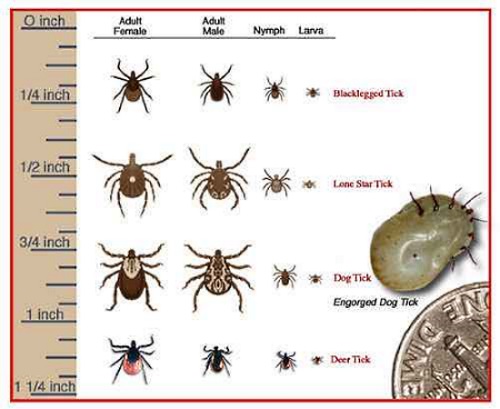Prep for a bad summer for ticks

According to the Centers for Disease Control and Prevention (CDC), the milder winters of the past few seasons and the rapidly increasing growth of mice and deer populations have combined to place a “tick” tock on the clock; a 2017 summer tick season (really kicking off now) that is expected to be bad and more widespread.
Milder winters and no snow cover or frost means more ticks survive the season.
Combine those survivors with urban sprawl of “dream homes” into woods and forests, and you have the combustible combination for the tick explosion.
And with any spike in ticks, the threat of more tick-borne diseases shoots up, including the most common, Lyme disease.
Mice thrive as woods and forests are cleared because their predators need big forests to survive. More mice means more hosts for baby ticks to latch onto – and they survive well when they feed on a mouse as compared to other animal hosts. Because of this, more ticks survive to the nymph stage. It is the mice that infects some ticks with Lyme and other diseases.
Without as many foxes, hawks and owls to eat them, mice multiply – rapidly. The end result is areas full of mice; mice that are chronically infected with Lyme and covered with ticks.
A surge in the deer population also means additional good “hosts” on which ticks can feed and spread. Fortunately, deer don’t infect the ticks, and when adult deer ticks bite humans, they are bigger and easier to detect and remove. On average, 10%-to-20% of deer nymphal ticks are infected with Lyme disease, depending on the region.
Most cases of Lyme disease in people, the most common vector-borne disease in the United States, are transmitted by nymph-stage ticks.
The Centers for Disease Control and Prevention estimates there are more than 300,000 new cases of Lyme disease a year, about triple the rate from two decades ago. Most cases are centered in the Northeast, mid-Atlantic region, northern Indiana and Illinois and the Upper Midwest states of Minnesota and Wisconsin.
Symptoms of Lyme disease can include a ring-like rash, along with flulike symptoms, muscle and joint aches and swollen lymph nodes. It is usually diagnosed based on symptoms or a blood test. It is treated with antibiotics. Longer-term infections can cause more serious symptoms, including arthritis, severe muscle pain and headaches, heart palpitations, brain inflammation and nerve pain. Diagnosis and treatment of Lyme disease is controversial with many differences of opinion between patient groups and doctors.
Ticks typically feed on humans for three-to-five days. A tick that latches on for only a few hours is unlikely to transmit infection. For Lyme disease to be transmitted, a tick usually has to be attached for 24-to-48 hours, though for some other diseases it is less time.
Ticks won’t crawl a lot once on a host, and are usually found on the lower extremities, as they cling onto legs when people are walking through wooded areas or grass. Sometimes they will drop down onto people from a higher bush and end up in someone’s hair or behind an ear.
Once done with a feeding, the tick will fall off on its own and be gone, which can make diagnosis of Lyme disease difficult.
In addition to Lyme disease, 10% of ticks have also tested positive for the pathogen that causes Babesiosis, a malaria-like disease, and 5% have tested positive for the bacteria that causes Anaplasmosis, a flulike disease that can be fatal if left untreated.
Valneva, a biotech company based in France, recently started a phase one clinical trial for a Lyme disease vaccine in humans in both Europe and the United States. The trial includes 180 subjects and is focusing on the safety of the vaccine. Unfortunately, approval is far away. A spokeswoman for the company said the first approval could happen at the end of 2024 at the earliest.
Tricks on avoiding ticks
+ Avoid tall grass, leaf piles and wooded areas. Stay in the center of walking and hiking trails.
+ Use repellent on skin and clothing that contains 20% (or more) DEET.
+ If camping or hiking, treat clothing and gear with permethrin.
+ When working outside or walking in the woods, wear long sleeves and long pants – and stick you pants inside your socks. Wear lighter-colored clothing so you can see ticks more easily.
+ Do a thorough tick check of the body using a mirror. Make sure teo check hard-to-reach areas, including under the arms, behind the ears, inside the belly button, behind the knees and in the groin area. A lice comb can help for checking hair.
+ Showering or bathing after spending time outside can wash off ticks that haven’t latched on yet.
+ Check pets and clothing and equipment that has been outside for crawling ticks.
+ Drying clohes on high heat for 10 minutes can kill ticks. Add additional drying time for wet clothes.
+ Regularly mow or trim your lawn to avoid tall grass and rake leaves.
+ Place a three-foot-wide barrier of gravel or wood chips between the lawn and wooded areas. Try to maintain a nine-foot barrier between the wood chips and areas such as the patio, garden and play areas.
+ Plant crops that deer don’t like or build an eight-foot-high fence to keep them out.
+ Spray the yard with araricides or tick pesticides to help reduce the number of ticks.
Removing a sticky tick
+ Use fine-tipped tweezers to grasp the tick as close to the skin’s surface as possible.
+ Pull upward with steady, even pressure. Don’t twist or jerk the tick; this can cause the mouth-parts to break off and remain in the skin. If this happens, remove the mouth-parts with tweezers. If you are unable to remove the mouth easily with clean tweezers, leave it alone and let the skin heal.
+ After removing the tick, thoroughly clean the bite area and your hands with rubbing alcohol, an iodine scrub or soap and water.
+ Dispose of a live tick by submersing it in alcohol, placing it in a sealed bag/container, wrapping it tightly in tape or flushing it down the toilet. Never crush a tick with your fingers.



















